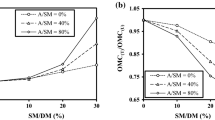Abstract
Many innovative ameliorating techniques including chemical stabilization have been in practice for enhancing the behavior of expansive clays. However, cement and lime are quite effective and successful chemical additives. Based on an experimental investigation, this paper discusses the influence of cement and lime on significant index and swelling properties of expansive clays. Cement and lime were mixed in various quantities (depending on chemicals) with highly swelling montmorillonitic expansive clays for investigating the variation of liquid limit (LL), plasticity index (PI), free swell index (FSI), rate of heave, swell potential (S%), and compression index (Cc). In geotechnical designs, the compression index is one of the major parameters to determine settlements in soils. This paper employed the heuristic models for the prediction of Cc of blended expansive clays. Particle swarm optimization (PSO) is an efficient and inspired computational search for various engineering disciplines. Hence, the PSO technique is used to estimate the compression index value from available data using a linear model. With availability of limited test data, close estimation is possible with PSO for the prediction of Cc. In the linear model Cc equation, the effect of additional coefficients chosen in the PSO prediction model is the key factor presented in this paper.







Similar content being viewed by others
References
Abu Farsakh M, Dhakal S, Chen Q (2015) Laboratory characterization of cementitiously treated/stabilized very weak subgrade soil under cyclic loading. Soils Found 55(3):504–516
AlRashidi MR, El-Hawary ME (2006) A survey of particle swarm optimization applications in electric power systems. IEEE Trans Evol Comput. https://doi.org/10.1109/TEVC.2006.880326
Aydm K, Adnan A (2007) A field application for lime stabilization. Environ Geol 51:987–997
Azzouz AS, Krizek RJ, Corotis RB (1976) Regression analysis of soil compressibility. Soils Found 16(2):19–29
Bansal JC, Singh PK, Saraswat M, Verma A, Jadon SS, Abraham A (2011) Inertia weight strategies in particle swarm optimization. In: 2011 Third world congress on nature and biologically inspired computing, pp. 633–640
Chen FH (1988) Foundations on expansive soils. Elsevier Scientific Publishing Co., Amsterdam
Cherian C, Arnepalli DN (2015) A critical appraisal of the role of clay mineralogy in lime stabilization. Int J Geosynth Ground Eng 1:8
Clerc M (2010) Particle swarm optimization. John Wiley and Sons
Das SK, Pijush S, Akshaya Kumar S, Sitharam TG (2010) Prediction of swelling pressure of soil using artificial intelligence techniques. Environ Earth Sci 16:393–403
Firoozi AA, Guney OC, Ali AF, Mojtaba SB (2017) Fundamentals of soil stabilization. Int J Geo-Eng 8(26):1–16
Hajihassani M, Armaghani DJ, Kalatehjari R (2017) Applications of particle swarm optimization in geotechnical engineering: a comprehensive review. Geotech Geol Eng. https://doi.org/10.1007/s10706-017-0356-z
Holtz WG, Gibbs HJ (1956) Engineering properties of expansive clays. Trans ASCE 121:641–677
Ismail A, Jeng D-s (2012) Empirical method for settlement prediction of single piles using higher order neural network and particle swarm optimization, GeoCongress 2012. ASCE. https://doi.org/10.1061/9780784412121.030
Kennedy J, Eberhart R (1995) Particle Swarm Optimization. IEEE, 0–7803–2768-3/95, pp 1942–1948
Komornik J, David A (1969) Prediction of swell potential for compacted clays. J Soil Mech Found Div ASCE 95(1):209–225
Koppula SD (1981) Statistical estimation of compression index. Geotech Test J 4(2):68–73
Lin B, Cerato AB (2012) Prediction of expansive soil swelling based on four micro-scale properties. Bull Eng Geol Environ 71:71–78
MacLean DJ, Lewis WA (1963) British practice in the design and specification of cement-stabilized bases and sub-bases for roads. Highw Res Rec 36:56–76
Mitchell JK (1976) Fundamentals of soil behaviour. Wiley series, Geotechnological Engineering Series, Volume 8
Mozumder RA, Laskar AI (2015) Prediction of unconfined compressive strength of geopolymer stabilized clayey soil using artificial neural network. Comput Geotech 69:291–300
Nelson DJ, Miller JD (1992) Expansive soils: problems and practice in foundation and pavement engineering. Wiley, New York
Neubauer CH, Thompson MR (1972) Stability properties of uncured lime-treated fine-grained soils. Highw Res Rec 381:20–26
Ninad KK, Nandedkar VM (2015) Particle swarm optimization applications to mechanical engineering – a review. Mater Today: Proc 2(4–5):2631–2639
Nishida Y (1956) A brief note on compression index of soils. J Soil Mech Found Eng Div 1(14):1027
Park HII, Lee SR (2011) Evaluation of the compression index of soils using an artificial neural networks. Comput Geotech 38:472–481
Phanikumar BR, Nagaraju TV (2018a) Engineering behaviour of expansive clays blended with cement and GGBS. Ground Improv. https://doi.org/10.1680/jgrim.17.00054
Phanikumar, B. R. and Nagaraju, T. V. (2018b). Swell compressibility characteristics of expansive clay lumps and powders blended with GGBS – a comparison. Indian Geotech J 1–9. ISSN 2277-3347
Phanikumar BR, Sreedharan R, Aniruddh (2015) Swell-compressibility characteristics of lime-blended and cement-blended expansive clays – a comparative study. Geomech Geoeng – Int J 10(2):153–162
Prasad CD, Nayak PK (2018) Performance assessment of swarm-assisted mean error estimation-based fault detection technique for transmission line protection. Compute Electric Eng 71:115–128
Rao AS, Phanikumar BR, Sharma RS (2004) Prediction of swelling characteristics of remoulded and compacted expansive soils using free swell index. Q J Eng Geol Hydrogeol 37(3):217–226
Seed HB, Woodward J, Lundgren R (1962) Prediction of swelling potential for compacted clays. J Soil Mech Found Div ASCE 88(SM3):53–87 part 1, Proc Paper 3169
Shankar NB, Maruthi G (1989) Use of lime-soil piles for in situ stabilization of black cotton soils. Proc Indian Geotech Conf 1:149–153
Sherwood PT (1962) Effect of sulphates on cement and lime-stabilized soils. High-way Res Board Bull 353:98–107
Sherwood PT (1995) Soil stabilization with cement and lime. HMSO publications center, London, pp 14–55
Skempton, A.W. (1953), The colloidal activity of clays Proc. 3rd Int. Conf. On S.M. & F.E., Zurich, Vol. 1, pp 57–61
Terzaghi K, Peck RB (1967) Soil mechanics in engineering practice, 2nd edn. Wiley, New York, p 73
Yazdi JS, Kalantary F, Yazdi HS (2012) Calibration of soil model parameters using particle swarm optimization. Int J Geomech 12(3):229–238
Author information
Authors and Affiliations
Corresponding author
Additional information
Responsible Editor: Zeynal Abiddin Erguler
Rights and permissions
About this article
Cite this article
Nagaraju, T.V., Prasad, C.D. Swarm-assisted multiple linear regression models for compression index (Cc) estimation of blended expansive clays. Arab J Geosci 13, 331 (2020). https://doi.org/10.1007/s12517-020-05287-w
Received:
Accepted:
Published:
DOI: https://doi.org/10.1007/s12517-020-05287-w




